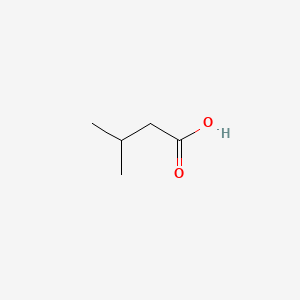ISOVALERIC ACID
ISOVALERIC ACID is a lipid of Fatty Acyls (FA) class. Isovaleric acid is associated with abnormalities such as Infection, Lymphocele, Cyst, Abscess and Subgingival plaque. The involved functions are known as Biochemical Reaction, 5-(carboxyamino)imidazole ribonucleotide mutase activity, nitrate reductase activity, urease activity and colony morphology. Isovaleric acid often locates in Skeleton, Abdomen, Chromosomes, Tissue membrane and Microsomes. The associated genes with ISOVALERIC ACID are trypticase, Operon, KCNT1 gene, Genome and Reverse primer. The related lipids are Fatty Acids, Propionate, Fatty Acids, Unsaturated, Steroids and Promega. The related experimental models are Knock-out.
References related to abnormalities published in Others
| PMID | Journal | Published Date | Author | Title |
|---|---|---|---|---|
| 11481456 | Proc. Natl. Acad. Sci. U.S.A. | 2001 | Ruan Y et al. | Ethanol hypersensitivity and olfactory discrimination defect in mice lacking a homolog of Drosophila neuralized. |
| 10713113 | J. Biol. Chem. | 2000 | Volchenboum SL and Vockley J | Mitochondrial import and processing of wild type and type III mutant isovaleryl-CoA dehydrogenase. |
| 18310025 | Microbiology (Reading, Engl.) | 2008 | Förster-Fromme K et al. | Biochemical characterization of AtuD from Pseudomonas aeruginosa, the first member of a new subgroup of acyl-CoA dehydrogenases with specificity for citronellyl-CoA. |
| 15939578 | FEMS Immunol. Med. Microbiol. | 2005 | van Nuenen MH et al. | The influence of microbial metabolites on human intestinal epithelial cells and macrophages in vitro. |
| 16952943 | J. Bacteriol. | 2006 | Bode HB et al. | 3-Hydroxy-3-methylglutaryl-coenzyme A (CoA) synthase is involved in biosynthesis of isovaleryl-CoA in the myxobacterium Myxococcus xanthus during fruiting body formation. |
